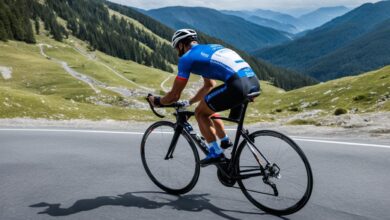Break Through Cycling Training Plateaus Effectively

Are you experiencing a fitness plateau in your cycling training? It can be frustrating when you’re putting in consistent effort but not seeing the improvements you desire. The good news is that overcoming cycling plateaus is possible with the right strategies and adjustments.
When you hit a plateau, it doesn’t mean you’ve reached your physical limits. It’s an opportunity to reassess your training, nutrition, and recovery to identify what might be holding you back. By making targeted changes, you can break through the plateau and improve your cycling performance.
Let’s explore some effective tips and solutions to help you overcome cycling plateaus and reach new heights in your training.
Key Takeaways:
- To overcome cycling plateaus, reassess your training, nutrition, and recovery strategies.
- Address the quality and quantity of your training stress to continue progressing.
- Add structure to your training to sustainably challenge your abilities.
- Make rest and recovery a priority to optimize your progress.
- Pay attention to proper nutrition and fueling to support your training.
Assessing Training Stress
If you’re struggling with a fitness plateau, it’s essential to assess the quality and quantity of your training stress. In order to achieve positive physical adaptations, your training needs to be challenging and consistent. The key is finding the right balance between pushing your body enough to stimulate improvements and allowing it enough time to recover.
When assessing your training stress, consider the following factors:
- Training Volume: If your current training volume isn’t sufficiently stressful, it means your body has adapted to that level and is no longer progressing. Increasing the volume of your training plan can help provide the necessary stimulus for growth. However, be mindful of your lifestyle and schedule to ensure the increased volume is maintainable.
- Training Quality: If your training volume is challenging but not consistently maintained, your body won’t have a chance to build fitness. Focus on the quality and specificity of your training stress. Incorporate structured workouts, intervals, and targeted sessions that closely align with your goals and desired adaptations.
Assessing your training stress requires an individualized approach. What works for one cyclist may not work for another. It’s important to listen to your body and make adjustments based on your own unique circumstances and goals.
“The key is finding the right balance between pushing your body enough to stimulate improvements and allowing it enough time to recover.”
Training stress can be a complex topic, and it’s often beneficial to seek guidance from a professional coach or trainer who can provide an objective assessment of your training plan and help you make adjustments. Their expertise can ensure that you’re effectively challenging yourself and progressing towards your desired performance goals.
By regularly assessing and adjusting your training stress, you can break through plateaus and continue to improve your cycling performance.
Adding Structure to Your Training
While getting out and spending time on your bike can initially help improve your performance, as your body adapts to unstructured training, achieving significant progress becomes more challenging. To overcome a training plateau, it is essential to add structure to your training regimen. Implementing high-quality structured training will sustainably challenge your abilities in the long term, allowing for continual improvement.
Increasing the specificity of your training load is key in promoting further adaptation and breaking through plateaus. By tailoring your training to target specific aspects of your performance, you can optimize your progress and performance. Whether your goal is to increase endurance, enhance power output, or improve sprinting capabilities, structuring your training plan to align with these objectives is crucial.
Not sure how to incorporate structure into your training? Consider utilizing a tool like Plan Builder. Plan Builder enables you to create a customized training plan tailored to your specific needs and goals. It takes into account factors such as your current fitness level, available training time, and the desired variability in your workouts. By using Plan Builder, you can ensure that your training plan includes the appropriate level of structure and variability to maximize your progress.
Benefits of Structured Training
Structured training offers several benefits for cyclists looking to break through plateaus and improve their performance:
- Optimized training stimuli: Structured training ensures that each workout targets specific physiological adaptations, enabling you to focus on areas that need improvement.
- Progressive overload: By gradually increasing the intensity and volume of your workouts, structured training provides the necessary stimulus for continual growth and performance gains.
- Efficient time usage: With a structured training plan, you can make the most of your available training time by ensuring that each workout has a specific purpose and aligns with your goals.
- Enhanced motivation: Knowing that your training plan has been thoughtfully designed with clear progressions and goals can boost your motivation and commitment to the process.
Structured training is an invaluable tool for cyclists aiming to unlock their full potential and overcome plateaus. By incorporating structured training into your regimen, you can enhance the effectiveness of your workouts, optimize your training adaptations, and achieve new levels of performance.
Image: Structured training enables cyclists to optimize their performance.
Rest and Recovery
Rest and recovery are integral components of an effective training program. When it comes to overcoming plateaus, giving your body the time it needs to rest and recover is essential. Athletes who push themselves too hard without allowing for proper rest may experience diminishing returns and hinder their progress. To maximize the benefits of your hard work and training stress, it’s crucial to strike a balance between training and adequate recovery.
Recovery needs can vary from person to person, depending on factors such as individual physiology and the level of training stress being endured. It’s important to listen to your body and recognize the signs of fatigue or overtraining. Ignoring these signals can lead to burnout and hinder progress.
Taking scheduled rest days is vital. These rest days provide an opportunity for your body to repair, regenerate, and adapt to the training stress. It’s during periods of rest that your body rebuilds muscles and replenishes energy stores, ensuring that you can perform at your best.
Effective recovery strategies go beyond simply taking rest days. Incorporating activities such as stretching, foam rolling, and low-intensity active recovery exercises can further promote muscle repair and reduce muscle soreness. Additionally, prioritizing quality sleep is crucial for overall recovery and hormone regulation.
Remember that recovery is not just physical. Mental rest is equally important. Engaging in stress-reducing activities, such as meditation or spending time in nature, can help alleviate mental fatigue and improve overall well-being.
H3: The Benefits of Restful Rest Days
Rest days should not be underestimated. They play a crucial role in allowing your body to adapt and grow stronger. Here are some key benefits of incorporating rest days into your training program:
- Reduces the risk of overtraining and burnout
- Prevents injuries and promotes injury recovery
- Enhances muscle repair and growth
- Improves immune system function
- Restores glycogen stores for improved energy
- Allows for mental rejuvenation and improved focus
By prioritizing rest and recovery, you give your body the opportunity to adapt, recover, and come back stronger. Don’t overlook the power of rest in your training program.
Nutrition and Fueling
Proper nutrition is crucial for overcoming a plateau and progressing in your training. Without adequate nutrition, completing difficult workouts becomes challenging, and your body may struggle to recover effectively. Pay attention to fueling your workouts with sufficient carbohydrates, hydrating properly, and supporting your recovery process. All principles of nutrition play a role in your progression as an athlete. If you suspect that insufficient fueling may be hindering your progress, it’s worth evaluating your nutrition and making adjustments to support your training.

The Importance of Carbohydrate Intake
Carbohydrates are a key fuel source for endurance athletes, providing the energy necessary for intense workouts. Consuming sufficient carbohydrates before, during, and after exercise can optimize your performance and aid in recovery. Aim to include a variety of complex and simple carbohydrates in your diet to meet the energy demands of your training.
Hydration for Optimal Performance
Staying properly hydrated is essential for optimal performance and recovery. Dehydration can negatively impact your endurance, cognitive function, and overall training quality. Make sure to drink fluids regularly throughout the day and monitor your hydration status during workouts. Remember that individual fluid needs may vary based on factors such as climate, intensity, and duration of exercise.
The Principles of Nutritious Eating
Adopting a balanced and nutritious eating plan is fundamental to your overall progress as an athlete. Incorporate a wide range of nutrient-dense foods into your diet to ensure you’re getting the vitamins, minerals, and antioxidants necessary for optimal health and performance. Prioritize whole foods, lean proteins, healthy fats, and a variety of fruits and vegetables to fuel your body effectively.
“Eating a well-balanced diet rich in nutrient-dense foods will provide the foundation for peak performance and recovery.”
Here’s a table summarizing key nutrition principles:
| Principle | Description |
|---|---|
| Macronutrient Balance | Achieve the right balance of carbohydrates, proteins, and fats to support energy production, muscle repair, and overall health. |
| Micronutrient-Rich Foods | Incorporate a variety of fruits, vegetables, whole grains, and lean proteins to obtain essential vitamins, minerals, and antioxidants. |
| Hydration | Maintain proper fluid balance to support performance, cognitive function, and recovery. Drink fluids regularly and monitor hydration status. |
| Pre-Workout Fueling | Consume easily digestible carbohydrates before workouts to provide immediate energy and optimize performance. |
| Post-Workout Recovery | Focus on consuming a combination of carbohydrates and protein within the first hour after exercise to support muscle repair and glycogen replenishment. |
By following these nutrition principles, you can ensure that your body is adequately fueled and ready to perform at its best.
Multifaceted Solutions
Overcoming a plateau often requires a multifaceted approach. There is no one-size-fits-all solution, and the right combination of training, nutrition, and rest may vary for each individual. Conducting an individual assessment of your training and nutrition can help you make the necessary adjustments to encourage progress. It’s important to address any specific areas that may be holding you back and implement changes accordingly. Remember that progress may require adding more stress, more rest, or a combination that suits your unique circumstances.
| Training | Nutrition | Rest |
|---|---|---|
| Assess your current training regimen and identify areas for improvement. | Evaluate your nutrition and ensure you’re fueling your body properly for optimal performance. | Give your body the rest it needs to recover and adapt to the training stress. |
| Consider adding variety to your workouts and increasing the intensity or volume as needed. | Focus on consuming nutrient-dense foods and meeting your body’s needs for energy and muscle recovery. | Prioritize quality sleep and relaxation to allow your body to recover and repair. |
| Seek expert guidance for personalized training plans and targeted workouts. | Adjust your macronutrient intake to support your training goals and optimize performance. | Implement rest days strategically to prevent overtraining and promote overall progress. |
By taking a comprehensive approach and addressing the different aspects of your training, nutrition, and rest, you can create a solid foundation for progress. Remember that consistency is key, and results may take time to manifest. Stay committed to your individualized approach and keep pushing forward towards your goals.
Increasing Training Density
As you continue your training journey, you may find it increasingly challenging to achieve performance breakthroughs and overcome plateaus. However, there is a powerful strategy that can help drive further adaptations and propel your progress: increasing training density.
Training density refers to the frequency and intensity of your training sessions. By strategically increasing these factors without necessarily adding more training hours, you can provide your body with a higher dose of training stress, pushing your limits and stimulating greater improvements.
Research has shown that incorporating an additional day or two of focused workouts or implementing block training can lead to significant enhancements in aerobic performance and overall fitness levels.
Block training involves grouping together consecutive training sessions that focus on a specific aspect of your cycling performance, such as endurance or speed. This concentrated approach allows for targeted adaptations and provides a unique stimulus to your body.
Finding the optimal training density for you is crucial. It’s important to challenge your abilities and push your limits without tipping into the realm of overtraining, which can hinder progress and increase the risk of injury.
To determine the ideal training density, consider factors such as your current fitness level, time availability, and recovery capacity. It may be beneficial to work with a qualified coach or training professional who can guide you in designing a personalized training program that maximizes your potential.
Remember, increasing training density can be an effective strategy for overcoming plateaus, unleashing your full potential, and achieving the breakthroughs you desire. However, it is crucial to approach it with careful consideration, ensuring that your training stimulus aligns with your individual needs and goals.
Benefits of Increasing Training Density:
- Stimulates greater training adaptations
- Enhances aerobic performance
- Breaks through training plateaus
- Increases overall fitness levels
- Optimizes time efficiency
Tips for Increasing Training Density:
- Gradually increase training frequency and intensity
- Include focused workouts targeting specific training goals
- Implement block training to provide concentrated stimulus
- Listen to your body and prioritize rest and recovery
- Work with a qualified coach or training professional for guidance
Example of Block Training Schedule:
| Training Phase | Training Focus | Frequency |
|---|---|---|
| Endurance | Long, steady rides | 3 sessions per week |
| Speed | Interval training | 2 sessions per week |
| Strength | Hill repeats | 2 sessions per week |
Monitoring Fatigue and Recovery
When it comes to increasing training density, one of the most crucial aspects to consider is monitoring fatigue levels and prioritizing adequate recovery. Fatigue is a natural response to intense physical exertion, and without proper recovery, it can hinder your progress and increase the risk of overtraining. In order to optimize your training, it’s important to implement individualized training plans that take into account your specific needs and goals.
Regular testing is an essential component of monitoring fatigue and recovery. Tests like Functional Threshold Power (FTP) or VO2max can provide valuable insights into your fitness level and help determine the best training days and intensities for you. By tracking your progress, you can make informed decisions about adjusting your training to maximize recovery and minimize the risk of injury.
Rest is a vital element in managing fatigue and promoting effective recovery. Rest days allow your body to repair and rebuild itself, reducing the chances of overuse injuries and providing the energy needed for future performance. By actively listening to your body’s signals and erring on the side of caution by incorporating more rest when needed, you can ensure that fatigue doesn’t accumulate and impede your progress.
Proper sleep, nutrition, and rest also play significant roles in your body’s ability to recover from higher-density training. Sleep is essential for the restoration of muscles and the production of hormones that regulate energy levels and promote recovery.
Optimal nutrition during and after training is critical to replenish energy stores, support muscle repair, and facilitate the recovery process. Eating a balanced diet that includes the right proportions of macronutrients and staying adequately hydrated will help you recover faster and maintain optimal performance.
By closely monitoring your fatigue levels, implementing individualized training plans, and prioritizing rest and nutrition, you can effectively manage fatigue, optimize recovery, and continue making progress even during periods of higher training density.
| Key Points for Monitoring Fatigue and Recovery: |
|---|
| Regularly test your fitness level to determine the best training days and intensities. |
| Listen to your body and prioritize rest when needed, preventing the accumulation of fatigue. |
| Ensure proper sleep, nutrition, and hydration to support your body’s recovery process. |
The Power of Training Density
Many cyclists underestimate their potential and assume they’ve reached their limits due to factors like limited time or age. However, adjusting the dose and recovery by increasing training density can unlock greater training potential. Studies have shown that increasing training frequency and focusing on block training can lead to significant improvements in performance. By finding the right balance of training stress and recovery, tailored to your specific circumstances, you can surpass your perceived limits and achieve breakthroughs. Individualized training plans, regular testing, and a personalized approach will help you maximize your training density and reach new levels of performance.
Training Frequency and Block Training
Increasing training frequency, or the number of training sessions per week, is one way to enhance training density. By adding more days of focused workouts, you provide your body with a higher dose of training stress, challenging your abilities and promoting adaptation. Additionally, implementing block training, where you focus on specific training stimuli for a concentrated period, can also boost training density and drive improvements in performance.
“By finding the right balance of training stress and recovery, tailored to your specific circumstances, you can surpass your perceived limits and achieve breakthroughs.”
Personalized Approach and Individualized Plans
Each cyclist is unique, with different goals, abilities, and limitations. To optimize training density, it’s crucial to take a personalized approach. Conducting regular assessments and tests can help determine the right training stress to apply and identify areas for improvement. By creating individualized training plans that consider these factors, you can tailor your training to suit your specific circumstances, maximizing the potential for progress.
Adjusting Dose and Recovery
When increasing training density, it’s essential to ensure appropriate dose and recovery. Pushing yourself too hard without adequate recovery can lead to overtraining and hinder performance gains. Conversely, not challenging yourself enough may result in limited progress. Finding the right balance between training stress and recovery is key. Listen to your body’s signals, prioritize restful rest days, and maintain proper nutrition to support your body’s ability to recover effectively.
By embracing the power of training density and adopting a personalized approach, you can tap into your full training potential, surpassing perceived barriers and achieving breakthroughs in performance. Don’t underestimate what you can accomplish with the right balance of challenge, recovery, and individualized planning.
Conclusion
Overcoming cycling plateaus requires a comprehensive approach that addresses training, nutrition, and recovery. By reassessing your training stress, adding structure and specificity, prioritizing rest and recovery, optimizing nutrition, and increasing training density, you can break through limitations and achieve greater performance.
To optimize your cycling performance, it is crucial to tailor your approach to your individual needs and goals. Seeking guidance from professionals when needed can provide valuable insights and support your journey towards success. With determination, proper planning, and a focus on continual improvement, you can unlock your potential and push past cycling plateaus.
Remember that progress takes time, consistency, and a commitment to the process. However, the rewards of overcoming these plateaus and reaching new levels of performance are worth the effort. Embrace effective training strategies, stay dedicated, and you will ultimately optimize your cycling performance and break through any limitations.
FAQ
How do I break through a cycling training plateau effectively?
To break through a cycling training plateau, you can reassess your training, nutrition, and recovery. Make sure your training stress is challenging and consistent, add structure to your training, prioritize rest and recovery, optimize your nutrition, and consider increasing training density. Progress takes time and a commitment to the process, but the rewards are worth it.
How can I assess my training stress?
Assessing your training stress involves evaluating the quality and quantity of your training. Make sure your training volume is sufficiently challenging and consistent. Consider trying a new training volume that is physically challenging yet maintainable. If you’re unsure, you can use tools like Plan Builder to create a custom training plan that suits your fitness goals.
Why is adding structure to my training important?
Adding structure to your training helps sustainably challenge your abilities in the long term. Unstructured training may provide initial improvements, but as your body adapts, significant progress becomes harder to achieve. High-quality structured training, with increased specificity, promotes continued adaptation and performance improvements.
How important is rest and recovery in overcoming a plateau?
Rest and recovery play a crucial role in overcoming a plateau. Balancing training stress with adequate rest allows your body to recover and maximize the benefits of your hard work. You may need to take a few days off or even a longer break to reset your mental and physical state. Prioritizing restful rest days dedicated to recovery is essential for progress.
How does nutrition affect my ability to overcome a plateau?
Proper nutrition is crucial for overcoming a plateau and progressing in your training. Without adequate nutrition, completing difficult workouts becomes challenging, and your body may struggle to recover effectively. Fuel your workouts with sufficient carbohydrates, hydrate properly, and pay attention to all principles of nutrition to support your training.
What approach should I take to overcome a plateau?
Overcoming a plateau often requires a multifaceted approach. Tailor your training, nutrition, and rest to your individual needs and goals. Conduct an individual assessment of your training and nutrition to make necessary adjustments. Address specific areas that may be holding you back and implement changes accordingly.
How can increasing training density help break through plateaus?
Increasing training density, which involves increasing the frequency and intensity of your training sessions without necessarily adding more hours, can provide your body with a higher dose of training stress. This can lead to further adaptations and performance improvements. Finding the optimal training density for you, balancing challenging workouts with sufficient recovery, is key.
Why is it important to monitor fatigue and recovery with increased training density?
With increased training density, it’s crucial to monitor fatigue levels and ensure adequate recovery. Individualized training plans that consider your specific needs and goals help manage fatigue and optimize recovery. Regular testing can help gauge progress and determine the best training days. Prioritize proper sleep, nutrition, and rest to support recovery from higher-density training.
How can training density unlock my training potential?
Many cyclists underestimate their potential and assume they’ve reached their limits. Adjusting the training dose and recovery by increasing training density can unlock greater training potential. Increasing training frequency and focusing on block training have been shown to lead to significant performance improvements. Individualized approaches tailored to your circumstances can help you push past plateaus and achieve breakthroughs.
What is the importance of a multifaceted approach in overcoming cycling plateaus?
Overcoming cycling plateaus requires a comprehensive approach that addresses training, nutrition, and recovery. Reassessing your training stress, adding structure and specificity, prioritizing rest and recovery, optimizing nutrition, and increasing training density are all important components. Tailor your approach to your unique circumstances, seeking guidance from professionals when needed.




